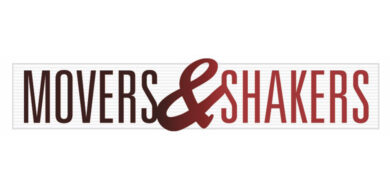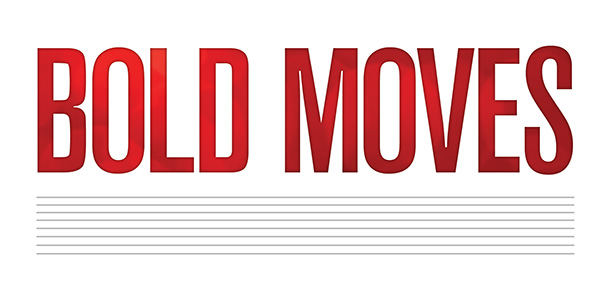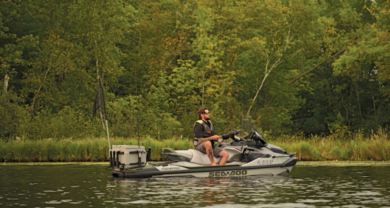Deck boats continue to appeal to boaters
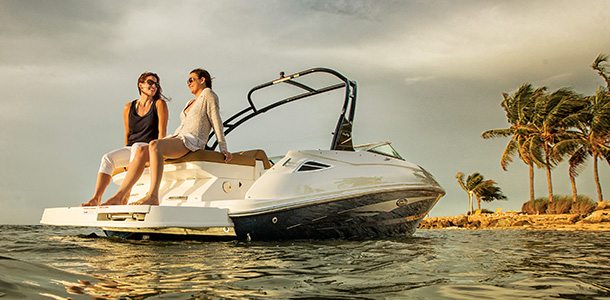
Seating more passengers than a bowrider and easier to tow than a pontoon, deck boats continue to appeal to boaters
Designed to blend the generous seating capacity and family-friendly layout of a pontoon boat with the familiar look and easy trailering of a traditional runabout, deck boats would appear to offer boaters an ideal compromise between practicality and performance. They have space for all the people and all the gear, yet they’re still fun to drive. Little wonder that so many manufacturers refer to deck boats as boating’s answer to the SUV.
At first glance most deck boats don’t look a whole lot different from the familiar bowrider, and it takes most buyers a moment to realize they retain their beam further forward than the traditional runabout does, and swap the pointy bow with a broader one that may even include an integral deck or swim platform. Sporty and stylish, deck boats come in a variety of configurations, in a choice of outboard or sterndrive power, some even with full windshields for additional comfort early or late in the season.
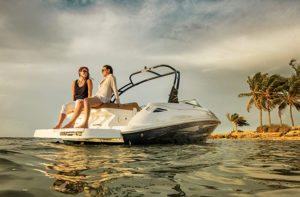
With so many positive attributes, one might expect deck boats to dominate all categories of boat sales. But do they? That’s not quite as straightforward question as it might appear, mainly because deck boats have changed and evolved significantly – and especially in the wake of the downturn and all the boating industry upheaval that followed.
By the numbers
The rapid development of new features and capabilities has blurred the traditional definition of exactly what a deck boat is. With the water between deck boats and runabouts increasingly muddied, measuring category performance has become more difficult, leading to some apparently contradictory results depending how one looks at the data.
For instance, the National Marine Manufacturers Association reports that deck boat sales were up by 11.3 percent in 2015, based on the organization’s control group of manufacturers which represent 69 percent of the market. Its 2016 numbers are still forthcoming, but overall boat sales are forecast to be up by 6 to 7 percent for the year.
Meanwhile, Statistical Surveys Inc. pegs year-over-year deck boat sales through June 2016 as being slightly down, albeit by a mere 0.39 percent. This follows reported category growth of 2.0 percent in 2015 and 2.76 percent in 2014.
An answer to the question of how the deck boat market goes seems to largely depend on where you are. Call 10 different dealers in 10 different states and you’ll get 10 different responses.
This is particularly evident in SSI’s 2016 sales figures by market. For its top 20 Basic Trading Areas, SSI notes an almost even split of declines and gains for the first six months of this year. Declines in the Fort Myers, Tampa/St. Petersburg/Clearwater, Miami/Fort Lauderdale, Houston, Detroit, Sarasota/Bradenton, Milwaukee, Orlando, Atlanta, Charlotte/Gastonia and Boston BTAs averaged a drop of 13.7 percent in overall volumes, while gains averaging a whopping 33 percent were reported for the New York, Minneapolis/St. Paul, Raleigh/Durham, Dallas/Fort Worth, Naples FL, Springfield MO and Philadelphia/Wilmington/Trenton BTAs.
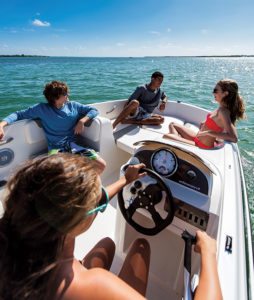
Just looking at the spread between the BTAs with the greatest sales declines (-24.81 percent, Fort Myers) and greatest gains (+60.42 percent, Dallas/Fort Worth) over the same period of time clearly reveals the challenge in accurately measuring deck boat category performance. To truly appreciate what’s going on, you have to look beyond the numbers and talk to the manufacturers directly.
A growing market
While sales figures may appear to be contradictory and lacking clear consensus, what cannot be denied is that over time the number of players in the deck boat market has steadily grown. That wouldn’t happen if there was nothing going on.
It’s also why a number of the builders have been watching the continuing evolution of Hurricane with a close eye. The company that created the deck boat market is reported to still hold about a 50 percent share, in spite of upheavals and uncertainty associated with its ownership change last year. “Hurricane created the deck boat market,” said Godfrey Marine director of marketing, Jeff Roth. “You might see a lag in our deck boat numbers over the last couple of quarters, which had to do with the disruption around our sale. We didn’t have as many units in the field as we would have liked. But that’s all in the past and we’re now looking ahead. Right now we’re building more deck boats per year than our next five top competitors. This is a strong category, which is why we have seen so many other brands enter it.”
Among their many attributes, Roth says that a major reason for the continuing popularity of deck boats is that they’re seen as being easier to tow than a pontoon, which makes them more approachable – especially to new boaters and first-time buyers. Further, their lower profile on a trailer can make them easier to store in a garage or barn, where a pontoon boat that sits higher on the trailer might not clear the door frame.
“For a lot of reasons, it’s a segment that continues to attract new buyers and attract new boaters,” says Roth.
Riding the outboard power wave
One of the great attractions to deck boats is their ability to offer a choice of either outboard or stern drive power. According to Tim Schiek, president of Brunswick’s Recreational Boat Group, both segments have shown growth in recent years.
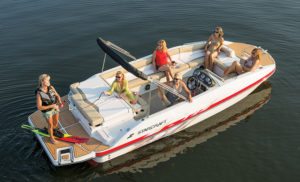
“Over the past five years we’ve seen the deck boat category growing nicely in both outboard and sterndrive power,” he said. “Both Sea Ray and Bayliner have picked up significant market share over the last few years. Growth has slowed a little bit over the past 12 months, but it is still moving in the right direction. The growth has been driven by both outboard and sterndrive models. But outboard power has obviously evolved tremendously, and is clearly driving the segment. We’re seeing good demand in outboard deck boats which has allowed Sea Ray and Bayliner to expand their product offering from sterndrive into outboard and really, attract a new consumer into the category.”
That new consumer, as often as not, is a younger family attracted by the deck boat’s versatility and creature comforts. Those new boaters with young children are often price-sensitive, and appreciate the lower acquisition and ownership cost of outboard power.
“The cost and value relationship between sterndrives and outboards has changed, as sterndrives have been forced to adopt catalysts and closed loop cooling systems, simply making outboards more affordable,” observes Bob vanVollenHoven, vice president of sales for Stingray Boats. “Beyond that, the technological advances in outboard power have driven a lot of sales, and opened up some new opportunities for Stingray in particular. Outboards allow a bit more cockpit space inside the boat, and they make it easier for a boater in Northern areas to prolong their season.”
Outboards also appeal in Southern, saltwater markets thanks to their ability to be tilted clear of the water when not in use.
“The Southeast is a strong deck boat market, and Florida in particular,” said Roth. “And that’s very much an outboard-driven market.”
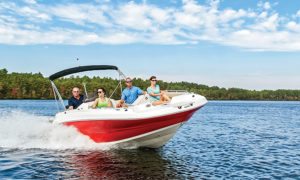
“Definitely, advances in outboard power over the last several years have helped grow the entire deck boat category,” noted Peter Barrett, senior vice president of marketing and corporate development at Smoker Craft Inc. “To the point deck boats now represent 85 percent of our fiberglass sales. The newest generation outboards offer the kind of power, performance and quiet, smoke-free operation that used to be the exclusive realm of the I/O. They’re less expensive than an I/O, and lighter in weight, which provides a real performance edge, particularly in the smaller boats that often appeal to an entry level buyer. With an outboard, these buyers can enjoy the same kind of exhilarating performance in that smaller package as you would find in a bigger boat powered by a much larger I/O.”
But what about sterndrives?
While there is clear consensus that technological advances in outboard power have benefitted deck boat dealers, a significant number of the deck boats made today retain the traditional I/O powerplant. What gives?
“Having said that, sterndrives have also evolved in substantial ways, bringing entirely new levels of performance for boaters who prefer the open stern and continuous, extended swim platform that an I/O allows,” continues Barrett. “Those extended platforms really make family boating easier, especially when you have kids enjoying tow sports and you’re passing boards or tubes back and forth. The I/O is a great fit to the clean, contemporary styling that we’re seeing in deck boats today, so the stern drive segment remains an important part of the overall market.”
For Brunswick – itself a manufacturer of both outboard and sterndrive engines – the deck boat market represents a nearly ideal platform for demonstrating the benefits of both forms of power.
“While we’re pleased with the success of our outboard products, sterndrives still play a very significant role in the deck boat market,” Schiek said. “We continue to invest in our sterndrive product line and we’ve enjoyed considerable success with our sterndrive-powered deck boats among both Sea Ray and Bayliner buyers. Having purpose-built stern drives like the 4.5L MerCruiser V6 and the 6.2L V8 enhances the entire ownership experience, and makes the segment that much more attractive to a prospective buyer.”
Continuous innovation
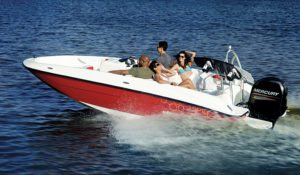
If there is one thing builders agree on, it is that the versatility that lies at the core of a deck boat’s value proposition is what will drive the category forward and provide it with a platform for continued market share growth.
“Customers tell us they appreciate having more creature comforts, more seating options, more entertaining options, and more comforts like a Porta-potti or a head – but without losing that open layout and the ease of access to the front of the boat,” said vanVollenHoven. “Customers want new amenities, and they want the boat to be more efficient and refined. We’re seeing customers shift from smaller bowriders to larger deck boats simply for the amenities the deck boat offers, and that’s not likely to change.”
Schiek takes an equally optimistic position. “We see the deck boat segment providing nice steady growth,” he said. “It won’t be explosive growth, but it will be steady and measured. I see it being fueled by innovations around functionality, by continued evolution in the use of space and accessibility of storage space in particular, to enhance overall usability.”
“Deck boats are very much the sporty SUV of the water,” Barrett said. “They provide all of the practicality of having plenty of interior space, with generous amounts of storage space and seating or the entire family, and blend that with the sporty handling and sleek styling of a performance boat. Yet they do that in a package that retains the open layout and easy access families want. You can do everything from a slow cruise to ripping across the lake with a bit of surfing in between. It’s the true family boat, and we’re looking for ways to add more versatility as we address the demands of today’s boaters with regards to technology, comfort and performance.”

